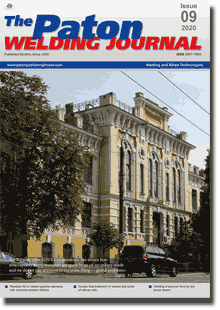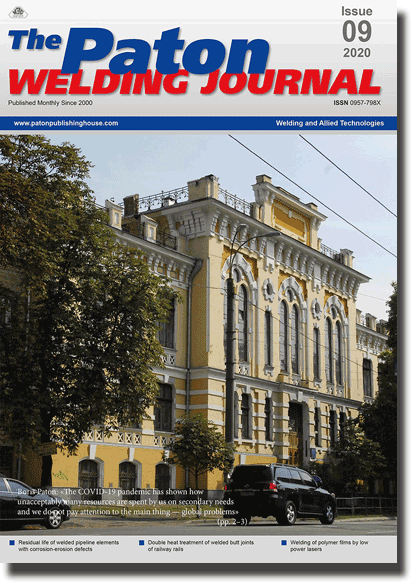| 2020 №09 (03) |
DOI of Article 10.37434/tpwj2020.09.04 |
2020 №09 (05) |

The Paton Welding Journal, 2020, #9, 26-30 pages
Effect of local heat treatment on mechanical properties of welded joints of intermetallic of tial system produced by electron beam welding
L.M. Lobanov, E.A. Asnis, N.V. Piskun, E.L. Vrzhyzhevskyi And L.M. Radchenko
E.O. Paton Electric Welding Institute of the NAS of Ukraine 11 Kazymyr Malevych Str., 03150, Kyiv, Ukraine. E-mail: office@paton.kiev.ua
Abstract
Welded joints of intermetallic β-stabilized alloy TiAl–Ti–44Al–5Nb–3Cr–1.5Zr (at.%) were investigated. Intermetallic billets of 3 and 10 mm thickness were welded by electron beam welding. In order to prevent arising of cold cracks in welded joints of titanium aluminide specimens of different thickness, the following postweld local heat treatment using an electron beam was performed. The mentioned method of treatment is one of the most attractive to improve the structure of ingot and reduce the level of residual welding stresses, which, in its turn, significantly increases mechanical properties of the alloy. Static tensile tests were performed to evaluate the strength of welded joints. The specimens fractured throughout the base material. The paper presents histograms showing the values of tensile strength (σt) of welded joints produced during tensile tests for the specimens of different thickness with and without the use of local heat treatment (lHT). It is shown that the use of local heat treatment increases tensile strength of the specimens of 3 and 10 mm thickness, as compared to the specimens produced without lHT. In addition, the values of this index for welded joints of different thicknesses, which are produced using this technique, are quite uniform. Comparative analysis of the results of tensile tests and the results of microhardness studies was performed, which showed that fracture of the specimens took place in the zone of lowering mechanical properties. The nature of fractures of different parts of welded joint was studied, which confirmed that fracture occurs in the zone of brittle part of the specimen. It is known that mechanical properties of welded joint are closely related to its structural state. During local heat treatment, an additional β0 (B2) phase appears in the structure, which increases the ductility of the weld material, 14 Ref., 2 Tables, 9 Figures. Keywords: intermetallic alloy of TiAl system, electron beam welding, local heat treatment, mechanical tensile tests, tensile strength, structural state, microhardness
Received 29.07.2020
References
1. Appel, F., Paul, J.D.H., Oering, M. (2011) Gamma titanium aluminide alloys. Sci. and Technol., WILEY-VCH, Weinheim. https://doi.org/10.1002/97835276362042. Kuchuk-Yatsenko, S.I., Zyakhor, I.V., Chernobaj, S.V. et al. (2015) Structure of β-TiAl joints in resistance butt welding with application of interlayers. The Paton Welding J., 9, 5-12. https://doi.org/10.15407/tpwj2015.09.01
3. Patterson, R.A. (1990) Titanium aluminide: electron beam weldability. Welding J., 1, 39-44.
4. Pflumma, R., Donchev, A., Mayer, S. et al. (2014) High-temperature oxidation behavior of multi-phase Mo-containing γ-TiAl-based alloys. Intermetallics, 53, 45-55. https://doi.org/10.1016/j.intermet.2014.04.010
5. Kulikovsky, R.A., Pakholka, S.N., Pavlenko, D.V. (2015) Prospects of industrial application of titanium aluminide in aircraft engine construction. Stroitelstvo, Materialovedenie, Mashinostroenie. Starodubov Lectures, 80, 369-372 [in Russian].
6. Xu, Q, Chaturvedi, MC, Richards, NL. (1999) The role of phase transformation in electron-beam welding of TiAl-based alloys. Metallurg. and Mater. Transact., A, 30A, 1717-1726. https://doi.org/10.1007/s11661-999-0171-0
7. Liu, J., Dahmen, M., Ventzke, V. et al. (2013)The effect of heat treatment on crack control and grain refinement in laser beam welded beta-solidifying TiAl-based alloy. Intermetallics, 40, 65-70. https://doi.org/10.1016/j.intermet.2013.04.007
8. Zamkov, V.N., Sabokar, I.K., Vrzhizhevsky, E.L. et al. (2005) Electron beam welding of γ-titanium aluminide. In: Proc. of Int. Conf. on Ti-2005 in CIS. Kiev, Naukova Dumka, 157- 164.
9. Chen, G.Q., Zhang, B.G., Liu, W., Feng, J.C. (2011) Crack formation and control upon the electron beam welding of TiAl-based alloys. Intermetallics, 19, 1857-1863. https://doi.org/10.1016/j.intermet.2011.07.017
10. Lobanov, L.M., Asnis, E.A., Piskun, N.V. et al. (2019) Investigation of stress-strain state of welded joints of the system TiAl intermetallics. The Paton Welding J., 11, 8-11. https://doi.org/10.15407/tpwj2019.11.02
11. Velikoivanenko, E.A., Milenin, A.S., Rozynka, G.F. et al. (2019) Prediction of cold cracking susceptibility of welded joints of γ-titanium aluminide based alloy in electron beam welding. Tekhnologicheskie Sistemy, 3, 59-66.
12. Pukhalskaya, G.V., Markov, I.B. (2016) Determination of mechanical properties in different zones of welded joints of titanium alloy VT3-1. Vestnik Dvigatelestroeniya, 1, 89-91 [in Russian].
13. Medvedev, A.Yu., Pavlini, S.P. (2012) Tensile tests of welded joints of titanium alloys performed by linear friction welding. Vestnik UGATY, 16, 7, 52, 68-71 [in Russian].
14. Nochovnaya, N.A., Panin, P.V. (2014) Analysis of residual macrostresses in welded joints of titanium alloys of different classes. Trudy VIAM, 5, 2 [in Russian]. https://doi.org/10.18577/2307-6046-2014-0-5-2-2
Suggested Citation
L.M. Lobanov, E.A. Asnis, N.V. Piskun, E.L. Vrzhyzhevskyi And L.M. Radchenko (2020) Effect of local heat treatment on mechanical properties of welded joints of intermetallic of tial system produced by electron beam welding. The Paton Welding J., 09, 26-30.The cost of subscription/purchase order journals or individual articles
| Journal/Currency | Annual Set | 1 issue printed |
1 issue |
one article |
| TPWJ/USD | 384 $ | 32 $ | 26 $ | 13 $ |
| TPWJ/EUR | 348 € | 29 € | 24 € | 12 € |
| TPWJ/UAH | 7200 UAH | 600 UAH | 600 UAH | 280 UAH |
| AS/UAH | 1800 UAH | 300 UAH | 300 UAH | 150 UAH |
| AS/USD | 192 $ | 32 $ | 26 $ | 13 $ |
| AS/EUR | 180 € | 30 € | 25 € | 12 € |
| SEM/UAH | 1200 UAH | 300 UAH | 300 UAH | 150 UAH |
| SEM/USD | 128 $ | 32 $ | 26 $ | 13 $ |
| SEM/EUR | 120 € | 30 € | 25 € | 12 € |
| TDNK/UAH | 1200 UAH | 300 UAH | 300 UAH | 150 UAH |
| TDNK/USD | 128 $ | 32 $ | 26 $ | 13 $ |
| TDNK/EUR | 120 € | 30 € | 25 € | 15 € |
AS = «Automatic Welding» - 6 issues per year;
TPWJ = «PATON WELDING JOURNAL» - 12 issues per year;
SEM = «Electrometallurgy Today» - 4 issues per year;
TDNK = «Technical Diagnostics and Non-Destructive Testing» - 4 issues per year.


